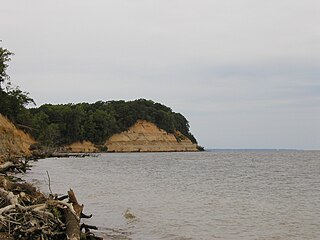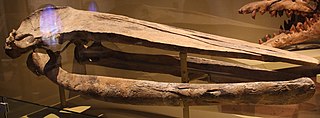
Carcharodon is a genus of sharks within the family Lamnidae, colloquially called the "white sharks." The only extant member is the great white shark. The extant species was preceded by a number of fossil (extinct) species including C. hubbelli and C. hastalis. The first appearance of the genus may have been as early as the Early Miocene or Late Oligocene. Carcharocles megalodon is still argued by some paleontologists to be a close relative of Carcharodon carcharias - as well as being in the same genus. The megalodon's scientific name was originally "Carcharodon" megalodon, but more recently, the giant shark has been assigned by most scientists to either the genus Carcharocles or Otodus.

Calvert Cliffs State Park is a public recreation area in Lusby, Calvert County, Maryland, that protects a portion of the cliffs that extend for 24 miles along the eastern flank of the Calvert Peninsula on the west side of Chesapeake Bay from Chesapeake Beach southward to Drum Point. The state park is known for the abundance of mainly Middle Miocene sub-epoch fossils that can be found on the shoreline.

Rachycentron is the only known member genus of the family Rachycentridae. The genus contains a single living species, the cobia, and the Late Miocene fossil species Rachycentron stremphaencus from Maryland.

Chrysemys is a genus of turtles in the family Emydidae. They are found throughout most of North America.

Eurhinodelphis is an extinct genus of Miocene cetacean. Its fossils have been found in Belgium, France, and Maryland.

Procolpochelys is an extinct genus of sea turtle from the Miocene of what is now Maryland, Virginia, and New Jersey. Its fossils have been found in the Calvert Formation. It was first named by Hay in 1908.
Leptophoca is an extinct genus of earless seals from the North Atlantic realm.

Ecphora is a genus of extinct predatory ocenebrinid murexes indigenous to the North American Eastern Seaboard from Miocene until their extinction during the Pliocene. The common name for this genus and a group of related genera is "ecphora"(s).

Aglaocetus is a genus of extinct baleen whales known from the Miocene of Patagonia, the US Eastern Seaboard, Japan and the Low Countries. It was once considered a member of Cetotheriidae along with many other putative cetotheres, but was recently recognized as representing a distinct family from true Cetotheriidae.

The Chesapeake Group is a geologic group in Maryland, Virginia, Delaware, and North Carolina. It preserves mainly marine fossils dating back to the Late Oligocene through the Pliocene epochs of the Neogene period. This group contains one of the best studied fossil record of Neogene oceans in the world. Professional Paleontologists and amateur fossil hunters alike collect from this group intensely. The Calvert Cliffs stretch the length of Calvert County, Maryland and provide the best continuous stretch of the Calvert, Choptank, and St. Marys Formations. Ward (1985) recommended including the Old Church Formation in this group.
The St. Marys Formation is a geologic formation in Maryland and Virginia, United States. It preserves fossils dating back to the Miocene Epoch of the Neogene period. It is the youngest Miocene formation present in the Calvert Cliffs and is part of the Chesapeake Group.

The Choptank Formation is a geologic formation in Virginia and Maryland. It preserves fossils dating from the Miocene epoch of the Neogene period.
Lopholatilus ereborensis is an extinct species of tilefish found in formations at Calvert Cliffs State Park in Lusby, Maryland. The species lived in the Salisbury Embayment in the Western North Atlantic during the Miocene era, 16 million years ago. The species is believed to have dug long, funnel-shaped vertical burrows in the continental shelf, the collapse of which may account for the remarkable preservation of the fossils. The species measured 18 inches (46 cm) long. The name is derived from "Erebor", the Elvish name for the Lonely Mountain from J.R.R. Tolkien's The Hobbit.
Araeodelphis is an extinct genus of river dolphin from the early Miocene of the East Coast of the United States.

Lophocetus is an extinct genus of dolphin belonging to the clade Delphinida that is known from late Miocene (Tortonian) marine deposits in California and Maryland. Although usually placed in Kentriodontidae, recent studies have found it only distantly related to Kentriodon.

Alopias grandis is a species of giant thresher shark from the Miocene. Estimates calculated from teeth comparisons suggest the living animal was comparable in size to the extant great white shark. Remains generally consist of teeth, which have been found in the United States in the Calvert Formation of Virginia and Maryland, and in Beaufort County, South Carolina. They have also been found in the Miocene of Malta. It is unlikely it possessed the elongated tail lobe of modern thresher sharks. Some specimens in the Burdigalian show the beginnings of serrations, which are presumably transitional individuals between A. grandis and A.palatasi.

Alopias palatasi, commonly referred to as the serrated giant thresher, is an extinct species of giant thresher shark that lived approximately 20.44 to 13.7 million years ago during the Miocene epoch, and is known for its uniquely serrated teeth. It is only known from such isolated teeth, which are large and can measure up to an excess of 4 centimetres (2 in), equating to a size rivaling the great white shark, but are rare and found in deposits in the East Coast of the United States and Malta. Teeth of A. palatasi are strikingly similar to those of the giant thresher Alopias grandis, and the former has been considered as a variant of the latter in the past. Scientists hypothesized that A. palatasi may have had attained lengths comparable with the great white shark and a body outline similar to it.

The Calvert Formation is a geologic formation in Maryland, Virginia, and Delaware. It preserves fossils dating back to the early to middle Miocene epoch of the Neogene period. It is one of the three formations which make up the Calvert Cliffs, all of which are part of the Chesapeake Group.

Messapicetus is an extinct genus of beaked whale from the Late Miocene. It currently holds two species, M. longirostris from the Tortonian of Italy and M. gregarius from the Pisco Formation of Peru. However, a third unnamed species is represented in the St. Marys Formation of Maryland known from fragmentary material. M. gregarius is sexually dimorphic, males having tusks which are hypothesized to have been used in intraspecific combat for mates as in extant (living) beaked whales.
Palaealectoris is an extinct monotypic genus of landfowl, belonging to the family Tetraonidae, distantly related with modern grouses. Its fossilized remains, found in the Marsland Formation, a part of the Agate Fossil Beds National Monument in Nebraska, and in the Calvert Formation in Maryland, are dated from the Early Miocene.














